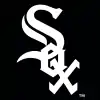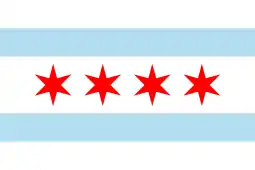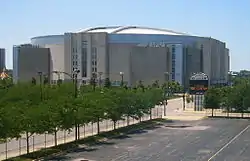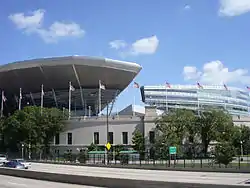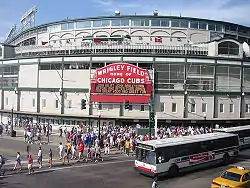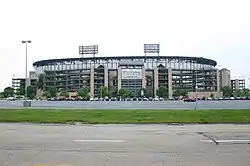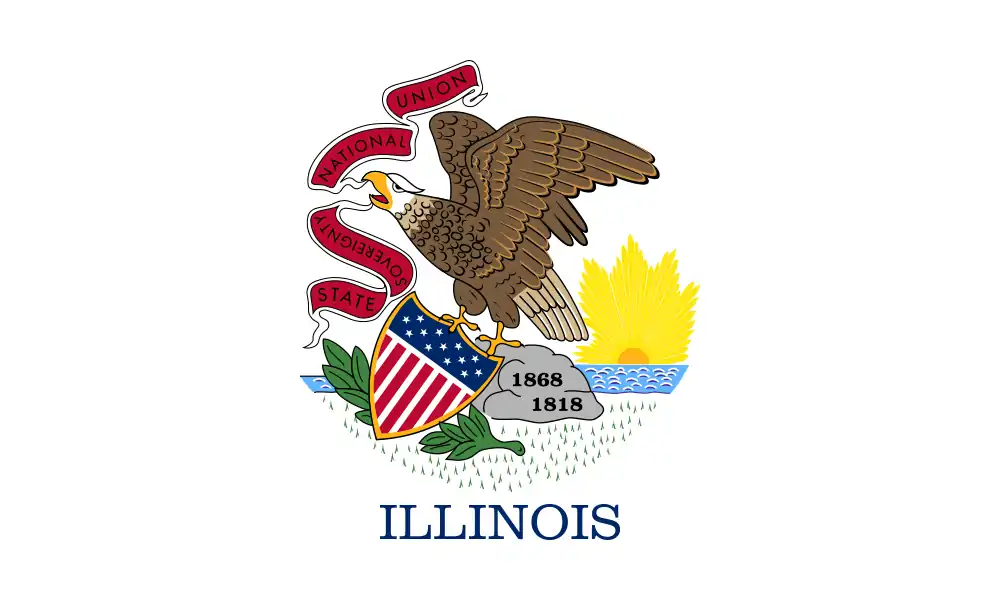Chicago White Sox
The Chicago White Sox are an American professional baseball team based in Chicago, Illinois. They compete in Major League Baseball (MLB) as a member club of the American League (AL) Central division. The White Sox are owned by Jerry Reinsdorf, and play their home games at Guaranteed Rate Field, located on the city's South Side. They are one of two major league clubs in Chicago; the other is the Chicago Cubs of the National League (NL) Central division.
| Chicago White Sox | |||||
|---|---|---|---|---|---|
| Established in 1900 | |||||
| |||||
| Major league affiliations | |||||
| |||||
| Current uniform | |||||
 | |||||
| Retired numbers | |||||
| Colors | |||||
| |||||
| Name | |||||
| Other nicknames | |||||
| |||||
| Ballpark | |||||
| |||||
| Major league titles | |||||
| World Series titles (3) | |||||
| AL Pennants (6) | |||||
| Division titles (5) | |||||
| Wild card berths (1) | |||||
| Front office | |||||
| Principal owner(s) | Jerry Reinsdorf | ||||
| President of baseball operations | Kenny Williams | ||||
| General manager | Rick Hahn | ||||
| Manager | Tony La Russa | ||||
One of the American League's eight charter franchises, the franchise was established as a major league baseball club in 1901. The club was originally called the Chicago White Stockings, but this was soon shortened to Chicago White Sox. The team originally played home games at South Side Park before moving to Comiskey Park in 1910, where they played until Guaranteed Rate Field (originally known as Comiskey Park and then known as U.S. Cellular Field) opened in 1991.
The White Sox won the 1906 World Series with a defense-oriented team dubbed "the Hitless Wonders", and the 1917 World Series led by Eddie Cicotte, Eddie Collins, and Shoeless Joe Jackson. The 1919 World Series was marred by the Black Sox Scandal, in which several members of the White Sox were accused of conspiring with gamblers to fix games. In response, Major League Baseball's new Commissioner Kenesaw Mountain Landis banned the players from Major League Baseball for life. In 1959, led by Early Wynn, Nellie Fox, Luis Aparicio and manager Al López, the White Sox won the American League pennant. They won the AL pennant in 2005, and went on to win the World Series, led by World Series MVP Jermaine Dye, Paul Konerko, Mark Buehrle, catcher A. J. Pierzynski, and the first Latino manager to win the World Series, Ozzie Guillén.
From 1901 to 2020, the White Sox have an overall record of 9,318–9,240 (.502).[3]
History

The White Sox originated as the Sioux City Cornhuskers of the Western League, a minor league under the parameters of the National Agreement with the National League. In 1894, Charles Comiskey bought the Cornhuskers and moved them to St. Paul, Minnesota, where they became the St. Paul Saints. In 1900, with the approval of Western League president Ban Johnson, Charles Comiskey moved the Saints into his hometown neighborhood of Armour Square, where they became known as the White Stockings, the former name of Chicago's National League team, the Orphans (now the Chicago Cubs).[4]
In 1901, the Western League broke the National Agreement and became the new major league American League. The first season in the American League ended with a White Stockings championship.[5] However, that would be the end of the season, as the World Series did not begin until 1903.[6] The franchise, now known as the Chicago White Sox, made its first World Series appearance in 1906, beating the crosstown Cubs in six games.[7]
The White Sox won a third pennant and second World Series in 1917, beating the New York Giants in six games with help from stars Eddie Cicotte and "Shoeless" Joe Jackson.[8] The Sox were heavily favored in the 1919 World Series, but lost to the Cincinnati Reds in eight games. Huge bets on the Reds fueled speculation that the series had been fixed. A criminal investigation went on in the 1920 season, and though all players were acquitted, commissioner Kenesaw Mountain Landis banned eight of the White Sox players for life, in what was known as the Black Sox Scandal.[9] This set the franchise back, as they did not win another pennant for 40 years.
The White Sox did not finish in the upper half of the American League again until after club founder Charles Comiskey died and passed ownership of the club to his son, J. Louis Comiskey.[10] They finished in the upper half most years between 1936 and 1946 under the leadership of manager Jimmy Dykes, with star shortstop Luke Appling, known as Ol' Aches and Pains, and pitcher Ted Lyons. Appling and Lyons have their numbers 4 and 16 retired.[11]
After J. Louis Comiskey died in 1939, ownership of the club was passed down to his widow, Grace Comiskey. The club was later passed down to Grace's children Dorothy and Chuck in 1956, with Dorothy selling a majority share to a group led by Bill Veeck after the 1958 season.[12] Veeck was notorious for his promotional stunts, attracting fans to Comiskey Park with the new "exploding scoreboard" and outfield shower. In 1961, Arthur Allyn, Jr. briefly owned the club before selling to his brother John Allyn.
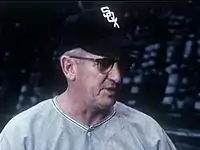
From 1951 to 1967, the White Sox had their longest period of sustained success, scoring a winning record for 17 straight seasons. Known as the "Go-Go White Sox" for their tendency to focus on speed and getting on base versus power hitting, they featured stars such as Minnie Miñoso,[13] Nellie Fox,[14] Luis Aparicio,[15] Billy Pierce,[16] and Sherm Lollar.[17] From 1957 to 1965, the Sox were managed by Al López. The Sox finished in the upper half of the American League in eight of his nine seasons, including six years in the top two of the league.[18] In 1959, the White Sox ended the New York Yankees' dominance over the American League, and won their first pennant since the ill-fated 1919 campaign.[19] Despite winning game one of the 1959 World Series 11–0, they fell to the Los Angeles Dodgers in six games.[20]
The late 1960s and 70s were a tumultuous time for the Sox, as they struggled to win games and attract fans. Allyn and Bud Selig agreed to a handshake deal that would give Selig control of the club and move them to Milwaukee; however, this was blocked by the American League.[21] Selig instead bought the Seattle Pilots and moved them to Milwaukee, putting enormous pressure on the American League to place a team in Seattle. A plan was in place for the Sox to move to Seattle and for Charlie Finley to move his Oakland A's to Chicago. However, Chicago had a renewed interest in the Sox after the 1972 season, and the American League instead added the expansion Seattle Mariners. The 1972 White Sox had the lone successful season of this era, as Dick Allen wound up winning the American League MVP award.[22] Some have said that Dick Allen is responsible for saving the White Sox in Chicago. Bill Veeck returned as owner of the Sox in 1975, and despite not having much money, they managed to win 90 games in 1977, a team known as the South Side Hitmen.
However, the team's fortunes plummeted after the 1977 season, plagued by 90-loss teams and scarred by the notorious Disco Demolition Night promotion in 1979.[23] Bill Veeck was forced to sell the team. He rejected offers from ownership groups intent on moving the club to Denver, eventually agreeing to sell the club to Ed DeBartolo, who was the only prospective owner who promised to keep the Sox in Chicago. However, DeBartolo was rejected by the owners, and the club was then sold to a group headed by Jerry Reinsdorf and Eddie Einhorn. The Reinsdorf era started off well, as the Sox won their first division title in 1983, led by manager Tony La Russa[24] and stars Carlton Fisk, Tom Paciorek, Ron Kittle, Harold Baines, and LaMarr Hoyt.[25] During the 1986 season, La Russa was fired by announcer-turned-GM Ken Harrelson. La Russa went on to manage in six World Series (winning three) with the Oakland A's and St. Louis Cardinals, ending up in the Hall of Fame as the third-winningest manager of all time.[26]
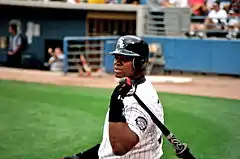
The White Sox struggled for the rest of the 1980s, as Chicago fought to keep the Sox in town. Reinsdorf wanted to replace the aging Comiskey Park, and sought public funds to do so. When talks stalled, a strong offer was made to move the team to the Tampa, Florida, area.[27] Funding for a new ballpark was approved in an 11th-hour deal by the Illinois State Legislature on June 30, 1988, with the stipulation that new park had to be built on the corner of 35th and Shields, across the street from the old ballpark, as opposed to the suburban ballpark the owners had designed.[21] Architects offered to redesign the ballpark to a more "retro" feel that would fit in the city blocks around Comiskey Park; however, the ownership group was set on a 1991 open date, so they kept the old design.[28] In 1991, the new Comiskey Park opened. However, it was rendered obsolete a year later with the opening of the retro-inspired Oriole Park at Camden Yards. The park, now known as Guaranteed Rate Field, underwent many renovations in the early 2000s to give it a more retro feel.
The White Sox were fairly successful in the 1990s and early 2000s, with 12 winning seasons from 1990 to 2005. First baseman Frank Thomas became the face of the franchise, ending his career as the White Sox's all-time leader in runs, doubles, home runs, total bases, and walks.[29] Other major players included Robin Ventura, Ozzie Guillén, Jack McDowell, and Bobby Thigpen.[30] The Sox won the West division in 1993, and were in first place in 1994 when the season was cancelled due to the 1994 MLB Strike.
In 2004, Ozzie Guillén was hired as manager of his former team.[31] After finishing second in 2004, the Sox won 99 games and the Central Division title in 2005 behind the work of stars Paul Konerko, Mark Buehrle, A. J. Pierzynski, Joe Crede, and Orlando Hernández.[32] They started the playoffs by sweeping the defending champion Boston Red Sox in the ALDS, and then beat the Angels in five games to win their first pennant in 46 years, due to four complete games by the White Sox rotation.[33] The White Sox went on to sweep the Houston Astros in the 2005 World Series, giving the Sox their first World Championship in 88 years.[34]
Guillén had marginal success during the rest of his tenure, with the Sox winning the Central Division title in 2008 after a one-game playoff with the Minnesota Twins.[35] However, Guillén left the White Sox after the 2011 season, and was replaced by former teammate Robin Ventura. The White Sox finished the 2015 season, their 115th in Chicago, with a 76–86 record, a three-game improvement over 2014.[36] The White Sox recorded their 9000th win in franchise history against the home team Detroit by the score of 3–2 on Monday, September 21, 2015. Ventura returned in 2016, with a young core featuring Jose Abreu, Adam Eaton, José Quintana, and Chris Sale.[37] Ventura resigned after the 2016 season in which the White Sox finished 78–84. Rick Renteria, the 2016 White Sox bench coach, was promoted to the role of manager.
Prior to the start of the 2017 season, the White Sox traded Sale to the Boston Red Sox and Eaton to the Washington Nationals for prospects including Yoan Moncada, Lucas Giolito, and Michael Kopech, signaling the beginning of a rebuilding period. During the 2017 season, the White Sox continued their rebuild when they made a blockbuster trade with their cross-town rival, the Chicago Cubs, in a swap that featured the White Sox sending pitcher José Quintana to the Cubs in exchange for four prospects headlined by outfielder Eloy Jimenez and pitcher Dylan Cease. This was the first trade between the White Sox and Cubs since the 2006 season.[38]
During the 2018 season, the White Sox faced a frightening situation when relief pitcher Danny Farquhar suffered a brain hemorrhage while he was in the dugout between innings.[39] Farquhar remained out of action for the rest of the season and just recently got medically cleared to return to baseball, despite some doctors doubting that he would make a full recovery.[40] Also occurring during the 2018 season, the White Sox announced that the club would be the first Major League Baseball team to entirely discontinuing use of plastic straws. The move was done in ordinance with the "Shedd the Straw" campaign by Shedd Aquarium.[41] The White Sox broke an MLB record during their 100-loss campaign of 2018, albeit not a record that was created by success. The White Sox broke the single-season strike out record in only a year after the Milwaukee Brewers broke the record in the 2017 season.[42] On December 3, 2018, White Sox head trainer, Herm Schneider, retired after 40 seasons with the team. Schneider's new role with the team will be as an advisor on medical issues pertaining to free agency, the amateur draft, and player acquisition. Schneider will also continue to be a resource for the White Sox training department, including both the major and minor league levels.[43]
Ballparks
In the late 1980s, the franchise threatened to relocate to Tampa Bay (as did the San Francisco Giants), but frantic[44] lobbying on the part of the Illinois governor James R. Thompson and state legislature resulted in approval (by one vote) of public funding for a new stadium. Designed primarily as a baseball stadium (as opposed to a "multipurpose" stadium) New Comiskey Park (redubbed U.S. Cellular in 2003 and Guaranteed Rate Field in 2016) was built in a 1960s style similar to Dodger Stadium and Kauffman Stadium. There were ideas for other stadium designs submitted to bring a more neighborhood feel, but ultimately they were not selected. It opened in 1991 to positive reviews; many praised its wide open concourses, excellent sight lines, and natural grass (unlike other stadiums of the era such as Rogers Centre in Toronto). The park's inaugural season drew 2,934,154 fans — at the time, an all-time attendance record for any Chicago baseball team.
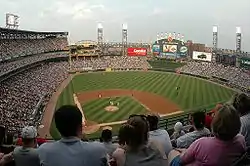
In recent years, money accrued from the sale of naming rights to the field has been allocated for renovations to make the park more aesthetically appealing and fan friendly. Notable renovations of early phases included: reorientation of the bullpens parallel to the field of play (thus decreasing slightly the formerly symmetrical dimensions of the outfield); filling seats in up to and shortening the outfield wall; ballooning foul-line seat sections out toward the field of play; creating a new multitiered batter's eye, allowing fans to see out through one-way screens from the center-field vantage point, and complete with concession stand and bar-style seating on its "fan deck"; and renovating all concourse areas with brick, historic murals, and new concession stand ornaments to establish a more friendly feel. The stadium's steel and concrete were repainted dark gray and black. The scoreboard Jumbotron was also replaced with a new Mitsubishi Diamondvision HDTV giant screen.
More recently, the top quarter of the upper deck was removed in 2004 and a black wrought-metal roof was placed over it, covering all but the first eight rows of seats. This decreased seating capacity from 47,098 to 40,615; 2005 also had the introduction of the Scout Seats, redesignating (and reupholstering) 200 lower-deck seats behind home plate as an exclusive area, with seat-side waitstaff and a complete restaurant located underneath the concourse. The most significant structural addition besides the new roof was 2005's FUNdamentals Deck, a multitiered structure on the left-field concourse containing batting cages, a small Tee Ball field, speed pitch, and several other child-themed activities intended to entertain and educate young fans with the help of coaching staff from the Chicago Bulls/Sox Training Academy. This structure was used during the 2005 playoffs by ESPN and Fox Broadcasting Company as a broadcasting platform.
Designed as a seven-phase plan, the renovations were completed before the 2007 season with the seventh and final phase. The most visible renovation in this final phase was replacing the original blue seats with green seats. The upper deck already had new green seats, put in before the beginning of the 2006 season. Beginning with the 2007 season, a new luxury-seating section was added in the former press box. This section has amenities similar to those of the Scout Seats section. After the 2007 season, the ballpark continued renovation projects despite the phases bring complete.
In July 2019, the White Sox extended the netting to the foul pole. This construction lasted over the 2019 All-Star Game.
Previous ballparks
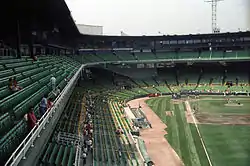
The St. Paul Saints first played their games at Lexington Park.[45] When they moved to Chicago's Armour Square neighborhood, they began play at the South Side Park. Previously a cricket ground, the park was located on the north side of 39th Street (now called Pershing Road) between South Wentworth and South Princeton Avenues.[46] Its massive dimensions yielded few home runs, which was to the advantage of the White Sox's Hitless Wonders teams of the early 20th century.[47]
After the 1909 season, the Sox moved five blocks to the north to play in the new Comiskey Park, while the 39th Street grounds became the home of the Chicago American Giants of the Negro leagues. Billed as the Baseball Palace of the World, it originally held 28,000 seats and eventually grew to hold over 50,000.[48] It became known for its many odd features, such as the outdoor shower and the exploding scoreboard. When it closed after the 1990 season, it was the oldest ballpark still in Major League Baseball.
Spring-training ballparks
The White Sox have held spring training in:[49]
|
|
|
On November 19, 2007, the cities of Glendale and Phoenix, Arizona, broke ground on the Cactus League's newest spring-training facility. Camelback Ranch, the $76 million, two-team facility is the new home of both the White Sox and the Los Angeles Dodgers for their spring training. Aside from state-of-the-art baseball facilities at the 10,000-seat stadium, the location includes residential, restaurant, and retail development, a four-star hotel, and an 18-hole golf course. Other amenities include 118,000 sq ft (11,000 m2) of major and minor league clubhouses for the two teams, four major league practice fields, eight minor league practice fields, two practice infields, and parking to accommodate 5,000 vehicles.[51]
Logos and uniforms
Over the years, the White Sox have become noted for many of their uniform innovations and changes. In 1960, they became the first team in the major sports to put players' last names on jerseys for identification purposes.
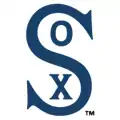
In 1912 the White Sox debuted a large "S" in a Roman-style font, with a small "O" inside the top loop of the "S" and a small "X" inside the bottom loop. This is the logo associated with the 1917 World Series championship team and the 1919 Black Sox. With a couple of brief interruptions, the dark-blue logo with the large "S" lasted through 1938 (but continued in a modified block style into the 1940s). Through the 1940s, the White Sox team colors were primarily navy blue trimmed with red.
The White Sox logo in the 1950s and 1960s (actually beginning in the 1949 season) was the word "SOX" in an Old English font, diagonally arranged, with the "S" larger than the other two letters. From 1949 through 1963, the primary color was black (trimmed with red after 1951). The Old English "SOX" in black lettering is the logo associated with the Go-Go Sox era.
In 1964, the primary color went back to navy blue, and the road uniforms changed from gray to pale blue. In 1971, the team's primary color changed from royal blue to red, with the color of their pinstripes and caps changing to red. The 1971–1975 uniform included red socks.
In 1976, the team's uniforms changed again. The team's primary color changed back from red to navy. The team based their uniforms on a style worn in the early days of the franchise, with white jerseys worn at home, and blue on the road. The team brought back white socks for the last time in team history. The socks featured a different stripe pattern every year. The team also had the option to wear blue or white pants with either jersey. Additionally, the team's "SOX" logo was changed to a modern-looking "SOX" in a bold font, with 'CHICAGO' written across the jersey. Finally, the team's logo featured a silhouette of a batter over the words "SOX".
The new uniforms also featured collars and were designed to be worn untucked — both unprecedented. Yet by far, the most unusual wrinkle was the option to wear shorts, which the White Sox did for the first game of a doubleheader against the Kansas City Royals in 1976. The Hollywood Stars of the Pacific Coast League had previously tried the same concept, but it was also poorly received. Apart from aesthetic issues, as a practical matter, shorts are not conducive to sliding, due to the likelihood of significant abrasions.
Upon taking over the team in 1980, new owners Eddie Einhorn and Jerry Reinsdorf announced a contest where fans were invited to create new uniforms for the White Sox. The winning entries submitted by a fan, had the word "SOX" was written across the front of the jersey, in the same font as a cap, inside of a large blue stripe trimmed with red. The red and blue stripes were also on the sleeves, and the road jerseys were gray to the home whites. In those jerseys, the White Sox won 99 games and the AL West championship in 1983, the best record in the majors.

After five years, those uniforms were retired and replaced with a more basic uniform that had "White Sox" written across the front in script, with "Chicago" on the front of the road jersey. The cap logo was also changed to a cursive "C", although the batter logo was retained for several years.
For a midseason 1990 game at Comiskey Park, the White Sox appeared once in a uniform based on that of the 1917 White Sox. They then switched their regular uniform style once more. In September, for the final series at Old Comiskey Park, the White Sox rolled out a new logo, a simplified version of the 1949-63 old English "SOX" logo. They also introduced a uniform with black pinstripes, also similar to the Go-Go Sox era uniform. The team's primary color changed back to black, this time with silver trim. The team also introduced a new sock logo—a white silhouette of a sock centered inside a white outline of a baseball diamond—which appeared as a sleeve patch on the away and alternate uniforms until 2011, when the patch was switched with the primary logo on the away uniform. With minor modifications (i.e., occasionally wearing vests, black game jerseys), the White Sox have used this style ever since.
During the 2012 and 2013 seasons, the White Sox wore their throwback uniforms at home every Sunday, starting with the 1972 red-pinstriped throwback jerseys worn during the 2012 season, followed by the 1981–86 uniforms the next season. In the 2014 season, the "Winning Ugly" throwbacks were promoted to full-time alternate status, and is now worn at home on Sundays. In one game during the 2014 season, they paired their throwbacks with a cap featuring the batter logo instead of the wordmark "SOX"; this is currently their batting-practice cap prior to games in the throwback uniforms.
Culture
Nicknames
The White Sox were originally known as the White Stockings, a reference to the original name of the Chicago Cubs.[52] To fit the name in headlines, local newspapers such as the Chicago Tribune abbreviated the name alternatively to Stox and Sox.[53] Charles Comiskey would officially adopt the White Sox nickname in the club's first years, making them the first team to officially use the "Sox" name. The Chicago White Sox are most prominently nicknamed "the South Siders", based on their particular district within Chicago. Other nicknames include the synonymous "Pale Hose";[54] "the ChiSox", a combination of "Chicago" and "Sox", used mostly by the national media to differentiate them between the Boston Red Sox (BoSox); and "the Good Guys", a reference to the team's one-time motto "Good guys wear black", coined by broadcaster Ken Harrelson. Most fans and Chicago media refer to the team as simply "the Sox". The Spanish language media sometimes refer to the team as Medias Blancas for "White Socks."
Several individual White Sox teams have received nicknames over the years:
- The 1906 team was known as the Hitless Wonders due to their .230 batting average, worst in the American League.[55] Despite their hitting woes, the Sox would beat the crosstown Cubs for their first world title.
- The 1919 White Sox are known as the Black Sox after eight players were banned from baseball for fixing the 1919 World Series.
- The 1959 White Sox were referred to as the Go-Go White Sox due to their speed-based offense. The period from 1950 to 1964, in which the White Sox had 15 consecutive winning seasons, is sometimes referred to as the Go-Go era.[56]
- The 1977 team was known as the South Side Hitmen as they contended for the division title after finishing last the year before.
- The 1983 White Sox became known as the Winning Ugly White Sox in response to Texas Rangers manager Doug Rader's derisive comments that the White Sox "...weren't playing well. They're winning ugly."[57] The Sox went on to win the 1983 American League West division on September 17.
Mascots

From 1961 until 1991, lifelong Chicago resident Andrew Rozdilsky performed as the unofficial yet popular mascot "Andy the Clown" for the White Sox at the original Comiskey Park. Known for his elongated "Come on you White Sox" battle cry, Andy got his start after a group of friends invited him to a Sox game in 1960, where he decided to wear his clown costume and entertain fans in his section. That response was so positive that when he won free 1961 season tickets, he decided to wear his costume to all games.[58] Comiskey Park ushers eventually offered free admission to Rozdilsky.[59] Starting in 1981, the new ownership group led by Jerry Reinsdorf introduced a twosome, called Ribbie and Roobarb, as the official team mascots, and banned Rozdilsky from performing in the lower seating level. Ribbie and Roobarb were very unpopular, as they were seen as an attempt to get rid of the beloved Andy the Clown.[60]
In 1988, the Sox got rid of Ribbie and Roobarb, and Andy The Clown was not permitted to perform in new Comiskey Park when it opened in 1991. In the early 1990s, the White Sox had a cartoon mascot named Waldo the White Sox Wolf that advertised the "Silver and Black Pack", the team's kids' club at the time. The team's current mascot, SouthPaw, was introduced in 2004 to attract young fans.[1][61]
Fight and theme songs
Nancy Faust became the White Sox organist in 1970, a position she held for 40 years.[62] She was one of the first ballpark organists to play pop music, and became known for her songs playing on the names of opposing players (such as Iron Butterfly's "In-A-Gadda-Da-Vida" for Pete Incaviglia).[63] Her many years with the White Sox established her as one of the last great stadium organists. Since 2011, Lori Moreland has served as the White Sox organist.[64]
Similar to the Boston Red Sox with "Sweet Caroline" (and two songs named "Tessie"), and the New York Yankees with "Theme from New York, New York", several songs have become associated with the White Sox over the years. They include:
- "Let's Go Go Go White Sox" by Captain Stubby and the Buccaneers – A tribute to the "Go-Go White Sox" of the late 1950s, this song serves as the unofficial fight song of the White Sox. In 2005, scoreboard operator Jeff Szynal found a record of the song and played it for a "Turn Back the Clock" game against the Los Angeles Dodgers, whom the Sox played in the 1959 World Series.[65] After catcher A. J. Pierzynski hit a walk-off home run, they kept the song around, as the White Sox went on to win the 2005 World Series.
- "Na Na Hey Hey Kiss Him Goodbye" by Steam – Organist Nancy Faust played this song during the 1977 pennant race when a Kansas City Royals pitcher was pulled, and it became an immediate hit with White Sox fans.[63] Faust is credited with making the song a stadium anthem and saving it from obscurity. To this day, the song remains closely associated with the White Sox, who play it when the team forces a pitching change, and occasionally on Sox home runs and victories.[66]
- "Sweet Home Chicago" – The Blues Brothers version of this Robert Johnson blues standard is played after White Sox games conclude.
- "Thunderstruck" by AC/DC – One of the most prominent songs for the White Sox player introductions, the hit song by AC/DC formed its bond with the team in 2005 and has since become a staple at White Sox home games.[67] The White Sox front office has tried several times to replace the song in an attempt to "shake things up", but White Sox fans have always showed their discontent towards a new song and they have successfully gotten the front office to keep the fan favorite song.[68]
- "Don't Stop Believin'" by Journey – During the 2005 season, the White Sox adopted the 1981 Journey song as their rally song after catcher A.J. Pierzynski suggested for it to be played through U.S. Cellular Field's speakers. During the 2005 World Series, the White Sox invited Journey's lead singer, Steve Perry, to Houston and allowed him to celebrate with the team on the field after the series-clinching sweep of the Houston Astros.[69] Perry also performed the song with members of the team during the team's victory parade in Chicago.
- "Don't Stop the Party" by Pitbull – After every White Sox home run at Guaranteed Rate Field, "Don't Stop the Party" by Pitbull is played over the loudspeakers.
Crosstown Classic
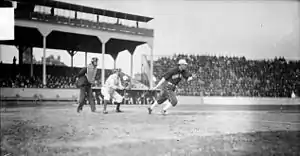
The Chicago Cubs are the crosstown rivals of the White Sox, a rivalry that some made fun of prior to the White Sox's 2005 title because both of them had extremely long championship droughts. The nature of the rivalry is unique; with the exception of the 1906 World Series, in which the White Sox upset the favored Cubs, the teams never met in an official game until 1997, when interleague play was introduced. In the intervening time, the two teams sometimes met for exhibition games. The White Sox currently lead the regular-season series 48–39, winning the last four seasons in a row. The BP Crosstown Cup was introduced in 2010 and the White Sox won the first three seasons (2010-2012) until the Cubs first won the Cup in 2013 by sweeping the season series. The White Sox won the Cup the next season and retained the Cup the following two years (series was a tie - Cup remains with defending team in the event of a tie). The Cubs took back the Cup in 2017. Two series sweeps have occurred since interleague play began, both by the Cubs in 1998 and 2013.
An example of this volatile rivalry is the game played between the White Sox and the Cubs at U.S. Cellular Field on May 20, 2006. White Sox catcher A. J. Pierzynski was running home on a sacrifice fly by center fielder Brian Anderson and smashed into Cubs catcher Michael Barrett, who was blocking home plate. Pierzynski lost his helmet in the collision, and slapped the plate as he rose. Barrett stopped him, and after exchanging a few words, punched Pierzynski in the face, causing a melee to ensue. Brian Anderson and Cubs first baseman John Mabry got involved in a separate confrontation, although Mabry was later determined to be attempting to be a peacemaker. After 10 minutes of conferring following the fight, the umpires ejected Pierzynski, Barrett, Anderson, and Mabry. As Pierzynski entered his dugout, he pumped his arms, causing the soldout crowd at U.S. Cellular Field to erupt in cheers. When play resumed, White Sox second baseman Tadahito Iguchi blasted a grand slam to put the White Sox up 5–0 on their way to a 7–0 win over their crosstown rivals.[70] While other major league cities and metropolitan areas have two teams co-exist, all of the others feature at least one team that began playing there in 1961 or later, whereas the White Sox and Cubs have been competing for their city's fans since 1901.
Historical
A historical regional rival was the St. Louis Browns. Through the 1953 season, the two teams were located fairly close to each other (including the 1901 season when the Browns were the Milwaukee Brewers), and could have been seen as the American League equivalent of the Cardinals–Cubs rivalry, being that Chicago and St. Louis have for years been connected by the same highway (U.S. Route 66 and now Interstate 55). The rivalry has been somewhat revived at times in the past, involving the Browns' current identity, the Baltimore Orioles, most notably in 1983.
The current Milwaukee Brewers franchise were arguably the White Sox's main and biggest rival, due to the proximity of the two cities (resulting in large numbers of White Sox fans who would regularly be in attendance at the Brewers' former home, Milwaukee County Stadium), and with the teams competing in the same American League division for the 1970 and 1971 seasons and then again from 1994 to 1997. The rivalry has since cooled off, however, when the Brewers moved to the National League in 1998.
Community Outreach
In 1990, then new White Sox owners Eddie Einhorn and Jerry Reinsdorf began Chicago White Sox Charities, a 501(c) (3) charitable organization that is the team's philanthropic arm, donating over $27 million over time to a plethora of Chicago organizations. White Sox Charities began centering on early childhood literacy programs, then expanded to focusing on encouraging high school graduation and college matriculation so the team can monitor its success. It also supports children at risk as well as promotes wellness and health.[71]
Home attendance
Comiskey Park
| Home attendance at Comiskey Park[72] | ||||
| Year | Total attendance | Game average | League rank | |
| 2000 | 1,947,799 | 24,047 | 9th | |
| 2001 | 1,766,172 | 21,805 | 12th | |
| 2002 | 1,676,911 | 20,703 | 10th | |
U.S. Cellular Field
| Home attendance at U.S. Cellular Field[73] | ||||
| Year | Total attendance | Game average | League rank | |
| 2003 | 1,939,524 | 23,945 | 9th | |
| 2004 | 1,930,537 | 23,834 | 8th | |
| 2005 | 2,342,833 | 28,924 | 7th | |
| 2006 | 2,957,414 | 36,511 | 3rd | |
| 2007 | 2,684,395 | 33,141 | 5th | |
| 2008 | 2,500,648 | 30,496 | 5th | |
| 2009 | 2,284,163 | 28,200 | 6th | |
| 2010 | 2,194,378 | 27,091 | 7th | |
| 2011 | 2,001,117 | 24,705 | 7th | |
| 2012 | 1,965,955 | 24,271 | 9th | |
| 2013 | 1,768,413 | 21,832 | 10th | |
| 2014 | 1,650,821 | 20,381 | 13th | |
| 2015 | 1,755,810 | 21,677 | 13th | |
| 2016 | 1,746,293 | 21,559 | 12th | |
Broadcasting
Radio
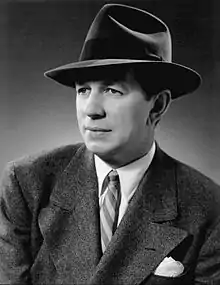
The White Sox did not sell exclusive rights for radio broadcasts from radio's inception until 1944, instead having local stations share rights for games, and after WGN (720) was forced to abdicate their rights to the team in the 1943 after 16 seasons due to children's programming commitments from their network, Mutual.[75][76] The White Sox first granted exclusive rights in 1944, and bounced between stations until 1952, when they started having all games broadcast on WCFL (1000).[77] Throughout this period of instability, one thing remained constant, the White Sox play-by-play announcer, Bob Elson. Known as the "Commander", Elson was the voice of the Sox from 1929 until his departure from the club in 1970.[78] In 1979, he was the recipient of the Ford Frick Award, and his profile is permanently on display in the National Baseball Hall of Fame.
After the 1966 season, radio rights shifted from WCFL to WMAQ (670). An NBC-owned and -operated station until 1988 when Westinghouse Broadcasting purchased it after NBC's withdrawal from radio, it was the home of the Sox until the 1996 season, outside of a team nadir in the early '70s, where it was forced to broker time on suburban La Grange's WTAQ (1300) and Evanston's WEAW-FM (105.1) to have their play-by-play air in some form (though WEAW transmitted from the John Hancock Center, FM radio was not established as a band for sports play-by-play at the time),[75] and a one-season contract on WBBM (780) in 1981. After Elson's retirement in 1970, Harry Caray began his tenure as the voice of the White Sox, on radio and on television. Although best remembered as a broadcaster for the rival Cubs, Caray was very popular with White Sox fans, pining for a "cold one" during broadcasts.[79] Caray often broadcast from the stands, sitting at a table set up amid the bleachers. It became a badge of honor among Sox fans to "Buy Harry a beer..." By game's end, one would see a large stack of empty beer cups beside his microphone. This only endeared him to fans that much more. In fact, he started his tradition of leading the fans in the singing of "Take Me Out To The Ballgame" with the Sox.[80] Caray, alongside color analyst Jimmy Piersall, was never afraid to criticize the Sox, which angered numerous Sox managers and players, notably Bill Melton and Chuck Tanner. He left to succeed Jack Brickhouse as the voice of the Cubs in 1981, where he became a national icon.
The White Sox shifted through several announcers in the 1980s, before hiring John Rooney as play-by-play announcer in 1989. In 1992, he was paired with color announcer Ed Farmer. In 14 seasons together, the duo became a highly celebrated announcing team, even being ranked by USA Today as the top broadcasting team in the American League.[81] Starting with Rooney and Farmer's fifth season together, Sox games returned to the 1000 AM frequency for the first time in 30 years (now the ESPN owned and operated station WMVP). The last game on WMVP was game 4 of the 2005 World Series, with the White Sox clinching their first World Series title in 88 years. That also was Rooney's last game with the Sox, as he left to join the radio broadcast team of the St. Louis Cardinals.
In 2006, radio broadcasts returned to 670 AM, this time on the sports radio station WSCR owned by CBS Radio (WSCR took over the 670 frequency in August 2000 as part of a number of shifts among CBS Radio properties to meet market ownership caps). Ed Farmer became the play-by-play man after Rooney left, joined in the booth by Chris Singleton from 2006 to 2007 and then Steve Stone in 2008. In 2009, Darrin Jackson became the color announcer for White Sox radio, where he remains today.[82] Farmer and Jackson were joined by pregame/postgame host Chris Rogney.
The Chicago White Sox Radio Network currently has 18 affiliates in three states.[83] As of recently, White Sox games are also broadcast in Spanish with play-by-play announcer Hector Molina joined in the booth by Billy Russo.[84] Formerly broadcasting on ESPN Deportes Radio via WNUA, games are now broadcast in Spanish on WRTO (1200).[85][86]
In the 2016 season, the play-by-play rights shifted to Cumulus Media's WLS (890) under a five-year deal, when WSCR acquired the rights to Cubs games after a one-year period on WBBM. However, by all counts, the deal was a disaster for the White Sox, as WLS's declining conservative talk format, associated ratings, and management/personnel issues (including said hosts barely promoting the team and its games), and a signal that is weak in the northern suburbs and into Wisconsin, was not a good fit for the team. Cumulus also had voluminous financial issues, and by the start of 2018, looked to both file Chapter 11 bankruptcy and get out of the play-by-play business entirely, both with local teams and nationally through their Westwood One/NFL deal.[87][75]
The White Sox and Tribune Broadcasting (which has since merged with Nexstar Media Group) then announced a three-year deal for WGN Radio to become the White Sox flagship as of February 14, 2018, just in time for spring training. Ed Farmer and Darrin Jackson continued to be on play-by-play, with Andy Masur taking over pregame/postgame duties.[88] Ed Farmer died suddenly on April 1, 2020 a long-term battle with polycystic kidney disease, but the team waited to announce his successor due to the COVID-19 pandemic.[89] On June 30, Masur was confirmed as Farmer's successor for the season.[90]
Under Nexstar's new management, WGN decided to pursue a thriftier programming direction, and made no moves to renew the deal at the end of the 2020 season. The team thus returned to WMVP (now managed by Good Karma Brands, which also owns Brewers flagship WTMJ) for a multi-year agreement to start with the 2021 season.[91] In a surprising turn of events, WMVP and the team announced on December 4, 2020 that Len Kasper, the longtime television play-by-play voice of the Cubs, would move to the South Side and become the radio play-by-play voice of the White Sox. The agreement has flexibility which allows Kasper to do some television games on NBC Sports Chicago on days when Jason Benetti has other national commitments.[92]
Television
White Sox games appeared sporadically on television throughout the first half of the 20th century, most commonly announced by Jack Brickhouse on WGN-TV (channel 9). Starting in 1968, Jack Drees took play-by-play duties as the Sox were broadcast on WFLD (channel 32).[93] After 1972, Harry Caray (joined by Jimmy Piersall in 1977) began double duty as a TV and radio announcer for the Sox, as broadcasts were moved to channel 44, WSNS-TV, from 1972 to 1980, followed by one year on WGN-TV.
Don Drysdale became the play-by-play announcer in 1982, as the White Sox began splitting their broadcasts between WFLD and the new regional cable television network, Sportsvision. Ahead of its time, Sportsvision had a chance to gain huge profits for the Sox. However, few people would subscribe to the channel after being used to free-to-air broadcasts for many years, along with Sportsvision being stunted by the city of Chicago's wiring for cable television taking much longer than many markets because of it being an area where over-the-air subscription services were still more popular, resulting in the franchise losing around $300,000 a month.[94] While this was going on, every Cubs game was on WGN, with Harry Caray becoming the national icon he never was with the White Sox. The relatively easy near-national access to Cubs games versus Sox games in this era, combined with the popularity of Caray and the Cubs being owned by the Tribune Company, is said by some to be the main cause of the Cubs' advantage in popularity over the Sox.
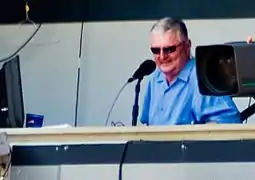
Three major changes to White Sox broadcasting happened each year from 1989 to 1991: in 1989 with the city finally fully wired for cable service, Sportsvision was replaced by SportsChannel Chicago (itself eventually turning into Fox Sports Net Chicago), which varied over its early years as a premium sports service and basic cable channel. In 1990, over-the-air broadcasts shifted back to WGN. And in 1991, Ken Harrelson became the play-by-play announcer of the White Sox.[95] One of the most polarizing figures in baseball, "Hawk" has been both adored and scorned for his emotive announcing style. His history of calling out umpires has earned him reprimands from the MLB commissioner's office, and he has been said to be the most biased announcer in baseball.[96] However, Harrelson has said that he is proud of being "the biggest homer in baseball", saying that he is a White Sox fan like his viewers.[97] The team moved from FSN Chicago to the newly launched NBC Sports Chicago in March 2005, as Jerry Reinsdorf looked to control the rights for his team rather than sell rights to another party; Reinsdorf holds a 40% interest in the network, with 20% of that interest directly owned by the White Sox corporation.
Previously, White Sox local television broadcasts were split between two channels: the majority of games were broadcast on cable by NBC Sports Chicago, and remaining games were produced by WGN Sports and were broadcast locally on WGN-TV. WGN games were also occasionally picked up by local stations in Illinois, Iowa, and Indiana. In the past, WGN games were broadcast nationally on the WGN America superstation, but those broadcasts ended after the 2014 season as WGN America began its transition to a standard cable network.[98] WGN Sports-produced White Sox games not carried by WGN-TV were carried by WCIU-TV (channel 26) until the 2015 season, when they moved to MyNetworkTV station WPWR (channel 50).[99] That arrangement ended on September 1, 2016 when WGN became an independent station.
Prior to 2016, the announcers were the same no matter where the games were broadcast: Harrelson provided play-by-play, and Steve Stone provided color analysis since 2009.[100] Games that are broadcast on NBC Sports Chicago feature pregame and postgame shows, hosted by Chuck Garfein with analysis from Bill Melton and occasionally Frank Thomas. In 2016, the team announced an official split of the play-by-play duties, with Harrelson calling road games and the Crosstown Series and Jason Benetti calling home games.[101] In 2017, the team announced that the 2018 season will be Harrelson's final in the booth. He will call 20 games over the course of the season, after which Benetti will take over full-time play-by-play duties.[102]
On January 2, 2019, the White Sox (along with the Chicago Bulls and Chicago Blackhawks) agreed to an exclusive multiyear deal with NBC Sports Chicago, ending the team's broadcasts on WGN-TV following the 2019 season.[103]
Personnel
Roster
Front office and key personnel
| Chicago White Sox key personnel | ||||||
| Chairman | Jerry Reinsdorf | |||||
| Senior Executive Vice President | Howard Pizer | |||||
| Executive Vice President | Ken Williams | |||||
| General Manager | Rick Hahn | |||||
| Senior Vice President, Administration | Tim Buzard | |||||
| Senior Vice President, Stadium Operations | Terry Savarise | |||||
| Senior Vice President, Communications | Scott Reifert | |||||
| Senior Vice President, Sales and Marketing | Brooks Boyer | |||||
| Vice President, General Counsel | John Corvino | |||||
| Head Groundskeeper | Roger Bossard | |||||
| Public Address Announcer | Gene Honda | |||||
| Organist | Lori Moreland | |||||
- Source:[104]
Awards and accolades
World Series championships
| Season | Manager | Regular season record | World Series opponent | World Series record | Ref | |
|---|---|---|---|---|---|---|
| 1906 | Fielder Jones | 93–58 | Chicago Cubs | 4–2 | [105] | |
| 1917 | Pants Rowland | 100–54 | New York Giants | 4–2 | [106] | |
| 2005 | Ozzie Guillén | 99–63 | Houston Astros | 4–0 | [107] | |
| 3 World Championships | ||||||
American League championships
Note: American League Championship Series began in 1969
| Season | Manager | Regular season record | AL Runner-Up/ALCS opponent | Games ahead/ALCS record | Ref | |
|---|---|---|---|---|---|---|
| 1901 | Clark Griffith | 83–53 | Boston Americans | 4.0 | [108] | |
| 1906 | Fielder Jones | 93–58 | New York Highlanders | 3.0 | [105] | |
| 1917 | Pants Rowland | 100–54 | Boston Red Sox | 9.0 | [106] | |
| 1919 | Kid Gleason | 88–52 | Cleveland Indians | 3.5 | [109] | |
| 1959 | Al López | 94–60 | Cleveland Indians | 5.0 | [110] | |
| 2005 | Ozzie Guillén | 99–63 | Los Angeles Angels | 4–1 | [107] | |
| 6 American League Championships | ||||||
Award winners
Team captains
- Luke Appling 1930–1950
- Ozzie Guillén 1990–1997
- Carlton Fisk 1990–1993
- Paul Konerko 2006–2014
Retired numbers
The White Sox have retired a total of 12 jersey numbers: 11 worn by former White Sox and number 42 in honor of Jackie Robinson.[111]
|
Luis Aparicio's number 11 was issued at his request for 11 time Gold Glove winner shortstop Omar Vizquel (because number 13 was used by manager Ozzie Guillén; Vizquel, like Aparicio and Guillen, play(ed) shortstop and all share a common Venezuelan heritage). Vizquel played for team in 2010 and 2011.[112]
Also, Harold Baines had his number 3 retired in 1989; it has since been 'unretired' 3 times in each of his subsequent returns.
Out of circulation, but not retired
- 6: Since Charley Lau's death in 1984, no White Sox player or coach (except Lau disciple Walt Hriniak, the Chicago White Sox's hitting coach from 1989 to 1995) has worn his number 6 jersey, although it has not been officially retired.
- 13: Since Ozzie Guillén left as manager of the White Sox, no Sox player or coach has worn his number 13 jersey, although it is not officially retired.
Baseball Hall of Famers
| Chicago White Sox Hall of Famers |
|---|
| Affiliation according to the National Baseball Hall of Fame and Museum |
|
Ford C. Frick Award recipients
| Chicago White Sox Ford C. Frick Award recipients | |||||||||
|---|---|---|---|---|---|---|---|---|---|
| Affiliation according to the National Baseball Hall of Fame and Museum | |||||||||
|
Minor league affiliates
The Chicago White Sox farm system consists of eight minor league affiliates.[113]
Silver Chalice subsidiary
Silver Chalice is a digital and media investment subsidiary of the White Sox with Brooks Boyers as CEO.[114]
Silver Chalice was co-founded by Jerry Reinsdorf, White Sox executive Brooks Boyer, Jason Coyle and John Burris in 2009.[114][115] Chalice has since partnered with IMG on Campus Insiders, a college sports digital channel.[114] The company also invested in 120 Sports, a digital sports channel, that launched in June 2016.[115] These efforts have since been merged with Sinclair Broadcasting Group's American Sports Network into the new multi-platform network Stadium as of September 2017.[116]
Notes
- The team's official colors are black and silver, according to the team's mascot (Southpaw)'s official website.[1]
References
- "About Southpaw". WhiteSox.com. MLB Advanced Media. Retrieved August 21, 2018.
- "Logos and Uniforms". WhiteSox.com. MLB Advanced Media. Retrieved December 17, 2018.
- "Chicago White Sox Team History & Encyclopedia". Baseball Reference. Baseball Info Solutions. Retrieved February 4, 2019.
- Bova, George (February 26, 2002). "Sox Fans' Guide to Sox Uniforms". FlyingSock.Com. White Sox Interactive. Archived from the original on December 21, 2018. Retrieved October 11, 2014.
- "1901, after having won in the minor league American League in 1900. American League Team Statistics and Standings". Baseball Reference. Sports Reference. Retrieved May 25, 2015.
- Stezano, Martin (October 24, 2012). "6 Things You May Not Know About the World Series". History. A&E Television Networks. Retrieved October 11, 2014.
- "1906 World Series". Baseball Reference. Sports Reference. Retrieved January 2, 2010.
- "1917 World Series". Baseball Reference. Sports Reference. Retrieved January 2, 2010.
- "The Black Sox". Chicago Historical Society. Archived from the original on August 15, 2014. Retrieved October 11, 2014.
- "J. Louis Comiskey". Baseball Library. Idea Logical. Archived from the original on September 22, 2015. Retrieved May 25, 2015.
- "Retired Numbers". WhiteSox.com. MLB Advanced Media. Retrieved October 11, 2014.
- "All-Time Owners". WhiteSox.com. MLB Advanced Media. Archived from the original on October 17, 2014. Retrieved October 11, 2014.
- "Minnie Miñoso". Baseball Reference. Sports Reference. Retrieved October 11, 2014.
- "Nellie Fox". Baseball Reference. Sports Reference. Retrieved October 11, 2014.
- "Luis Aparicio". Baseball Reference. Sport Reference. Retrieved October 11, 2014.
- "Billy Pierce". Baseball Reference. Sport Reference. Retrieved October 11, 2014.
- "Sherm Lollar". Baseball Reference. Sport Reference. Retrieved October 11, 2014.
- "Al López". Baseball Reference. Sport Reference. Retrieved October 11, 2014.
- "1959 Chicago White Sox season". Baseball Reference. Sport Reference. Retrieved October 11, 2014.
- "1959 World Series". MLB.com. MLB Advanced Media. Retrieved October 11, 2014.
- Bova, George. "Save Our Sox!". FlyingSock.com. White Sox Interactive. Retrieved May 25, 2015.
- "Dick Allen". Baseball Reference. Sport Reference. Retrieved October 11, 2014.
- Vettel, Phil. "Steve Dahl's Disco Demolition at Comiskey Park". Chicago Tribune. Retrieved October 11, 2014.
- "Tony La Russa". Baseball Reference. Sport Reference. Retrieved October 11, 2014.
- "1983 Chicago White Sox Season". Baseball Reference. Sport Reference. Retrieved October 11, 2014.
- Garfein, Chuck (February 4, 2013). "Hawk Opens Up on Firing La Russa". CSN Chicago. Archived from the original on September 23, 2015. Retrieved May 26, 2015.
- Sullivan, Paul Francis (June 21, 2011). "The Franchise moves that never happened". The Hardball Times. Retrieved May 26, 2015.
- Bova, George. "A Conversation with Phillip Bess". FlyingSock.com. White Sox Interactive. Retrieved October 11, 2014.
- "Frank Thomas". National Baseball Hall of Fame and Museum. Retrieved October 11, 2014.
- "1993 Chicago White Sox". Baseball Reference. Sport Reference. Archived from the original on February 10, 2009. Retrieved October 11, 2014.
- "Guillen Back with White Sox as Manager". ESPN. November 5, 2003. Retrieved May 25, 2015.
- "2005 Chicago White Sox". Baseball Reference. Sport Reference. Retrieved October 11, 2014.
- "2005 ALCS". Baseball Reference. Sport Reference. Retrieved October 11, 2014.
- "White Sox end 88-year drought, sweep Astros to win World Series". ESPN. October 27, 2005. Retrieved May 25, 2015.
- Merkin, Scott (October 1, 2008). "White Sox claim AL Central Crown". WhiteSox.com. MLB Advanced Media. Archived from the original on November 24, 2015. Retrieved May 25, 2015.
- van Schouwen, Daryl (October 4, 2015). "White Sox blanked in fitting finish to 2015". Chicago Sun-Times. Archived from the original on October 9, 2015. Retrieved October 9, 2015.
- "2014 Chicago White Sox season". Baseball Reference. Sport Reference. Retrieved October 11, 2014.
- "White Sox, Cubs cold war is over with Jose Quintana trade". USA TODAY. Retrieved December 3, 2018.
- "White Sox Reliever Danny Farquhar Has Brain Hemorrhage During Game". Retrieved November 30, 2018.
- "Danny Farquhar: Clears final hurdle". CBSSports.com. Retrieved November 30, 2018.
- Kane, Colleen. "White Sox are 1st MLB team to ditch single-use plastic straws". chicagotribune.com. Retrieved November 30, 2018.
- "White Sox batters break season strikeout record". ESPN.com. Retrieved December 3, 2018.
- "Herm Schneider to become head athletic trainer emeritus in 2019 after 40 seasons". MLB.com. Retrieved December 12, 2018.
- Kass, John (May 12, 1988). "Thompson: Sox Vow To Stay If Bill Passes". Chicago Tribune.
- Thornley, Stew (2004). "Twin Cities Ballparks". stewthornley.net. Retrieved May 26, 2015.
- "U.S. Cellular Field History". WhiteSox.com. MLB Advanced Media. Retrieved June 8, 2014.
- Healey, Paul. "South Side Park". Project Ballpark. Retrieved June 8, 2014.
- Fletcher, David J. "Never on a Friday". Chicago Baseball Museum. Retrieved June 8, 2014.
- "Chicago White Sox Spring Training".
- "Chicago White Sox: Spring Training History". Spring Training Online. August Publications. Archived from the original on September 4, 2005. Retrieved May 26, 2015.
- "Let's Play Ball!". Glendale AZ. June 26, 2007. Retrieved May 26, 2015.
- "Chicago Cubs Team History & Encyclopedia". Baseball Reference. Sports Reference. Retrieved December 28, 2014.
- Engber, Daniel (October 25, 2015). "X Marks The Baseball team". Explainer. Slate. Retrieved May 25, 2015.
- DeFord, Frank (May 18, 2005). "The Finest Nickname in Baseball". National Public Radio. Retrieved May 25, 2015.
- "1906: The Hitless Wonders". This Great Game. Retrieved December 28, 2014.
- Secter, Bob. "The 1959 'Go-Go' White Sox and the air-raid sirens". Chicago Tribune. Retrieved December 28, 2014.
- Evans, Sean (April 25, 2012). "The 25 Greatest Moments in White Sox History". Complex. Retrieved May 25, 2015.
- Singer, Stacey (September 24, 1995). "Andrew Rozdilsky, 77, Clown for Sox". Chicago Tribune. Retrieved May 25, 2015.
- Ley, Tom (January 14, 2014). "A Brief History of Terrible Chicago Mascots". Deadspin. Retrieved May 25, 2015.
- "White Sox History: The sad story of Ribbie and Roobarb". South Side Sox. SBNation. March 16, 2013. Retrieved May 25, 2015.
- Padilla, Doug (January 23, 2014). "Sox: 'No grief about our mascot'". ESPNChicago.com. ESPN Internet Ventures, LLC. Retrieved May 25, 2015.
- Crouse, Karen (September 17, 2010). "Ballpark Farewell, Played Adagio". The New York Times. Retrieved April 8, 2015.
- Vickery, Hal. "Flashing Back with Nancy Faust". FlyingSock.com. White Sox Interactive. Retrieved May 25, 2015.
- Austen, Jake (June 30, 2011). "An organist transplant for the White Sox". Chicago Reader. Sun-Times Media. Retrieved May 25, 2015.
- Theiser, Kelly (October 18, 2005). "Go-Go song revival a hit with fans". White Sox official website. MLB Advanced Media. Archived from the original on April 13, 2015. Retrieved May 25, 2015.
- Brown, David (October 24, 2011). "Goodbye, Paul Leka: Writer of sports anthem 'Na Na Hey Hey' dies". Yahoo! Sports. Retrieved May 25, 2015.
- bravewords.com. "AC/DC - 'Thunderstruck' Builds Fever Pitch For Chicago White Sox". bravewords.com. Retrieved November 18, 2018.
- Samuelson, Kristin. "Cris Quintana brings back 'Thunderstruck' after Twitter shade from White Sox fans". RedEye Chicago. Retrieved November 18, 2018.
- "ESPN: The Worldwide Leader in Sports". ESPN.com. Retrieved November 26, 2018.
- "Cubs' Barrett slugs Pierzynski, leads to melee". ESPN.com. May 20, 2006. Retrieved November 5, 2018.
- Brown, Darrell J. (Spring 2017). "Giving Back". Leaders. New York NY: Leaders Magazine LLC.
- "Chicago White Sox Attendance, Stadiums, and Park Factors". Baseball-Reference.com. Retrieved September 8, 2020.
- "Chicago White Sox Attendance, Stadiums, and Park Factors". Baseball-Reference.com. Retrieved September 8, 2020.
- "Chicago White Sox Attendance, Stadiums, and Park Factors". Baseball-Reference.com. Retrieved September 8, 2020.
- Castle, George (February 14, 2018). "WGN-Radio and 720 signal best possible 2018 home for White Sox". Chicago Baseball Museum. Retrieved February 17, 2018.
- "All-Time Broadcasters". WhiteSox.com. MLB Advanced Media. Retrieved October 11, 2014.
- "Right on Q: A brief history of the White Sox on the radio". South Side Sox. SB Nation. May 17, 2014. Retrieved May 25, 2015.
- "1979 Ford Frick Award Winner Bob Elson". National Baseball Hall of Fame and Museum. Retrieved October 11, 2014.
- "1989 Ford Frick Award Winner Harry Caray". National Baseball Hall of Fame and Museum. Retrieved October 11, 2014.
- Bohn, Matt. "Harry Caray". SABR.org. Society for American Baseball Research. Retrieved October 11, 2014.
- Gardner, Steve (July 26, 2005). "Rooney, Farmer give White Sox AL's top radio team". USA Today. Retrieved May 25, 2015.
- "Broadcasters". WhiteSox.com. MLB Advanced Media. Retrieved October 11, 2014.
- "Radio Affiliates". WhiteSox.com. MLB Advanced Media. Retrieved October 11, 2014.
- "White Sox Announce new Spanish radio broadcasters". WhiteSox.com. MLB Advanced Media. March 28, 2012. Retrieved May 25, 2015.
- "2015 Broadcast Schedule". Official Site of the Chicago White Sox. MLB Advanced Media. Retrieved March 4, 2015.
- Hart, Rob (May 17, 2014). "Right on Q: A brief history of the White Sox on the radio". South Side Sox. SBNation. Retrieved February 17, 2018.
- Rosenthal, Phil (January 18, 2018). "WLS-AM parent company asks court to end 'unprofitable' White Sox, Bulls deals". Chicago Tribune. Retrieved January 31, 2018.
- Feder, Robert (February 14, 2018). "Play ball! WGN Radio picks up White Sox". Robert Feder blog. Retrieved February 15, 2018.
- Merkin, Scott (April 2, 2020). "White Sox announcer Ed Farmer, 70, dies". MLB.com. Retrieved April 4, 2020.
- Rosenthal, Phil (June 30, 2020). "Andy Masur: New Chicago White Sox radio voice - Chicago Tribune". Chicago Tribune. Retrieved July 2, 2020.
- Feder, Robert (November 12, 2020). "Done deal: White Sox radio broadcasts return to ESPN 1000". Retrieved December 7, 2020.
- Feder, Robert (December 4, 2020). "Cubs TV announcer Len Kasper named radio voice of White Sox on ESPN 1000". Retrieved December 7, 2020.
- "All-Time Broadcasters- Television". WhiteSox.com. MLB Advanced Media. Retrieved October 11, 2014.
- "White Sox History: The story of SportsVision". South Side Sox. SB Nation. November 30, 2012. Retrieved October 11, 2014.
- Edelman, Alexander. "Ken Harrelson". SABR.org. Society for American Baseball Research. Retrieved October 11, 2014.
- "Selig reprimands Harrelson for rant against umpire". Chicago Tribune. June 1, 2012. Retrieved May 25, 2015.
- Diamond, Jared (September 26, 2012). "How Biased Is Your Announcer?". The Wall Street Journal. Retrieved May 25, 2015.
- Feder, Robert (December 15, 2014). "WGN America comes home to Chicago". Robert Feder. Retrieved May 25, 2015.
- Sherman, Ed (February 19, 2015). "White Sox add WPWR-Ch. 50 to station rotation". Chicago Tribune. Retrieved May 25, 2015.
- Berger, Ralph. "Steve Stone". SABR.org. Society for American Baseball Research. Retrieved October 11, 2014.
- Van Schouwen, Daryl (June 24, 2016). "White Sox adding Jason Benetti to play-by-play team". Chicago Sun-Times. Retrieved June 17, 2017.
- Kane, Colleen (May 31, 2017). "Ken 'Hawk' Harrelson to retire in 2018 after 'greatest ride of my life'". Chicago Tribune. Retrieved June 17, 2017.
- "NBC Sports Chicago Announces New Pact With White Sox, Bulls, and Blackhawks". WMAQ-TV. January 2, 2019. Retrieved January 4, 2019.
- "Chicago White Sox Front Office". Official Site of the Chicago White Sox. MLB Advanced Media. Retrieved June 8, 2014.
- "1906 Chicago White Sox". Baseball Reference. Sports Reference. Retrieved June 7, 2014.
- "1917 Chicago White Sox". Baseball Reference. Sports Reference. Retrieved June 7, 2014.
- "2005 Chicago White Sox". Baseball Reference. Sports Reference. Retrieved June 7, 2014.
- "1901 Chicago White Sox". Baseball Reference. Sports Reference. Retrieved June 7, 2014.
- "1919 Chicago White Sox". Baseball Reference. Sports Reference. Retrieved June 7, 2014.
- "1959 Chicago White Sox". Baseball Reference. Sports Reference. Retrieved June 7, 2014.
- "Retired Numbers". Chicago White Sox. Retrieved September 17, 2015.
- "White Sox Un-Retire Aparicio's Number, Vizquel to Wear No. 11 During 2010 Season". Press release. WhiteSox.com. MLB Advanced Media. February 8, 2010. Archived from the original on January 12, 2015. Retrieved May 26, 2015.
- "Chicago White Sox Minor League Affiliates". Baseball-Reference. Sports Reference. Retrieved May 14, 2020.
- Sherman, Ed (April 21, 2014). "Executive Profile: Brooks Boyer". Chicago Tribune. pp. 1–3. Retrieved August 17, 2016.
- Channick, Robert (June 25, 2014). "All-digital 120 Sports kicking off streaming network". Chicago Tribune. Tronc. Retrieved August 17, 2016.
- Marszalek, Diana (September 12, 2017). "Stadium Sports Network Rolls Out on Broadcast TV". Broadcasting & Cable. Retrieved November 6, 2017.
External links
| Wikimedia Commons has media related to Chicago White Sox. |
| Awards and achievements | ||
|---|---|---|
| Preceded by New York Giants 1905 |
World Series champions Chicago White Sox 1906 |
Succeeded by Chicago Cubs 1907 |
| Preceded by Boston Red Sox 1916 |
World Series champions Chicago White Sox 1917 |
Succeeded by Boston Red Sox 1918 |
| Preceded by Boston Red Sox 2004 |
World Series champions Chicago White Sox 2005 |
Succeeded by St. Louis Cardinals 2006 |
| Awards and achievements | ||
|---|---|---|
| Preceded by First American League champions |
American League champions Chicago White Sox 1900 and 1901 |
Succeeded by Philadelphia Athletics 1902 |
| Preceded by Philadelphia Athletics 1905 |
American League champions Chicago White Sox 1906 |
Succeeded by Detroit Tigers 1907 |
| Preceded by Boston Red Sox 1916 |
American League champions Chicago White Sox 1917 |
Succeeded by Boston Red Sox 1918 |
| Preceded by Boston Red Sox 1918 |
American League champions Chicago White Sox 1919 |
Succeeded by Cleveland Indians 1920 |
| Preceded by New York Yankees 1958 |
American League champions Chicago White Sox 1959 |
Succeeded by New York Yankees 1960 |
| Preceded by Boston Red Sox 2004 |
American League champions Chicago White Sox 2005 |
Succeeded by Detroit Tigers 2006 |
| Awards and achievements | ||
|---|---|---|
| Preceded by California Angels 1982 |
American League West champions Chicago White Sox 1983 |
Succeeded by Kansas City Royals 1984 |
| Preceded by Oakland Athletics 1992 |
American League West champions Chicago White Sox 1993 |
Succeeded by Seattle Mariners 1995 |
| Preceded by Cleveland Indians 1999 |
American League Central champions Chicago White Sox 2000 |
Succeeded by Cleveland Indians 2001 |
| Preceded by Minnesota Twins 2004 |
American League Central champions Chicago White Sox 2005 |
Succeeded by Minnesota Twins 2006 |
| Preceded by Cleveland Indians 2007 |
American League Central champions Chicago White Sox 2008 |
Succeeded by Minnesota Twins 2009 |

